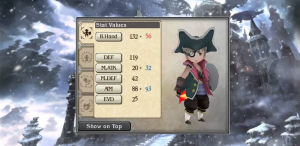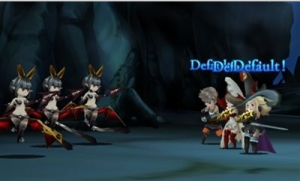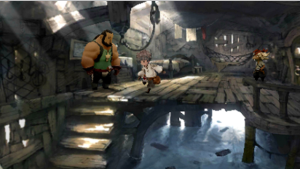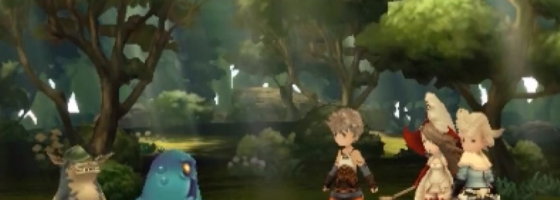A few years back, Square Enix released Final Fantasy: The 4 Warriors of Light, a game that was meant to be a throwback to older Final Fantasy and JRPG design — With a job system, a lack of cut-scenes and more. The game built up a cult following but the extreme difficulty and older design decisions did hold it back somewhat.
Bravely Default is the spiritual sequel to it from the same team and shows a growth in the design and mechanics present in Warriors of Light. However, while the developers did take steps forward, they’re still clinging to the past with some tired design decisions.
Four Against The World:
The story of Bravely Default finds the world in peril: Seas have become poisonous, the wind has stopped, monsters are out of control and so on. It turns out that four crystals that keep the world in balance have lost their power. Forcing the crystal vassal Agnes and her friends Tiz, Edna and Ringabel to go on a globetrotting quest to save everyone.
While the major plot of the game is a bit standard, the game does take an interesting turn with side quests and the general chemistry of the group. The group will have cut-scenes talking about recent events and the game tends to use humor to describe Agnes’ unfamiliarity with the outside world or Ringabel’s obsession with the ladies.
Despite the cheery graphics, this is not your happy go lucky RPG. Plenty of people, both good and bad are killed in the game and don’t expect any last minute changes of heart from the bad guys. If someone is bad, they’re going to remain bad up until you probably finish them off.
Where Bravely Default does standout from other JRPGs is in the collection of systems and mechanics that are used. Let’s start with combat that builds off of the traditional turned based JRPG style. To attack, characters expend Brave points or BP per round, with some attacks costing more BP.

The various jobs all feature unique costumes and skills to let you build a party of your own choosing.
Instead of attacking, you can use the “Default” command to defend and store BP in reserve. With a limit of three BP points per person; any further use of default will still defend but not store more BP.
During any round, you can expend BP to make multiple commands in a single round, up to four commands. For example, you could have your main damage dealer go all out, perform emergency heals, use spells and so on. Now, your BP storage can go into the negative and if you start a round with negative BP, you won’t be able to do anything with that character until they get back to zero.
It’s important to note that every enemy in the game makes use of this system as well, giving a certain flow to battles. You’ll have to decide when to go all out, save BP or just perform single commands. To make things more interesting, Bravely Default also features a great job system.
Jobs are another name for classes and allowing you to specialize your team. Each job will affect the base stats of the person, what skills they can use in combat, determines what gear the class can use the best and has a special job passive ability. Winning fights will earn you job points or JP, which can be used to level jobs up and unlock new abilities, both passive and active.
Because jobs do have an impact on your overall stats, you don’t want to switch to a new job if you’re fighting a boss or tougher enemies. A really great touch with the job system is the ability to specialize your characters further. Each character can use the commands from a second job of your choosing as well as equip passive skills from any unlocked job.
For example, you could give the valkyrie class who uses a two handed spear, the two handed perk from the knight class that increases weapon damage with two handed weapons. And then combine that with the valkyrie jump ability that receives a three times multiplier when using spears to really up the damage potential.
Unlocking new jobs comes in the form of side quests where as a nice touch; you earn them by fighting bosses who are masters in that class. And if you think that’s all the unique systems of Bravely Default, there’s more.
Using the social features of the 3DS, you can summon characters from your friends during a round of combat, allow your characters to use skills from someone else and there is a meta game option as well. Part of the story is that Tiz’s village gets wiped out and he has to rebuild it. Using street pass or connecting to the internet once a day will unlock villagers that can be put to work rebuilding his village.
The reconstruction unlocks new shops that sell high end equipment that you can buy as well as unlocking one more feature of combat: Special moves. Every weapon type in the game has a special move and condition for activating it. The shops in the village not only sell new moves that you can use, but modifiers that can be attached, allowing you to even customize your special attacks.
But perhaps the most welcome feature of Bravely Default for hardcore fans is the ability to adjust the enemy encounter rate. Starting at 0, you can change it anytime to go from a max of 100% to a minimum of – 100%. Allowing you to either get into fights every second, or completely turn off random encounters by your choice. This is a great idea and allows people to either focus on improving their characters or moving the story forward.

The flow of combat in Bravely Default is quite different from traditional JRPGs thanks to the BP system.
I’ve said this before but I really love it when Square-Enix decides to go off the rails or away from traditional JRPG design and Bravely Default definitely fits that pattern despite a lot of old school ideas.
This is the first time since Shin Megami Tensei 4 that an analysis for an RPG is going to go over 1000 words and that shows just how much there is to Bravely Default.
However, while the developers have made strides to distance the game from some of the annoyances of JRPG design, a few unfortunately still found their way into the game.
Needs Some Renovation:
The main problem for me with Bravely Default is that despite all the new systems and rules, the developers still used the conventional JRPG foundation and it somewhat neuters the growth of the mechanics.
While there are a lot of jobs in the game, you’ll find that a lot of them just don’t work as well as other ones due to the boss designs. One of my biggest pet peeves with a lot of JRPG games is that they give you all these tools in the form of status affecting spells and such, but then just flip a switch and say that all the bosses are immune to them.
Bosses tend to make use of high damaging attacks, either single or multi targeted, practically requiring the white mage job or skills to mitigate the damage and keep everyone going as there aren’t a lot of classes with healing options. I hate when designers force party compositions in games like this as it just shows the limitation of the systems they created.
A great counter example comes from Etrian Odyssey 4 that allowed the player to make use of all their abilities on every enemy encounter. This allowed you to develop interesting strategies and synergies that could be used even during boss fights. For example, during the final fight, I made use of my aliment inducer to keep the boss poison, confused, etc. While another character attacked who received increased damage by striking aliment affected enemies.
Not only that, but healing abilities were spread across the various classes, lessening the need to always have a medic.
But in Bravely Default, I found it very annoying at how bosses were simply aliment immune, while it was so easy for them to inflict it on my characters. It seemed like the boss fights were less about being challenged and more about figuring out the correct job composition to use.

For a handheld game, Square Enix did go the extra mile in terms of background visuals and a lot of voice acting.
Another problem is that despite the developer’s best intentions, the game is a bit of a slog at the start.
Since you won’t have a lot of jobs available or the ability to equip multiple passive abilities, combat was a bit boring.
And expect to spend a lot of time grinding away JP when you need to change your strategy for a specific fight or for a newly unlocked job class. Along with grinding to unlock the job specific passive abilities for every character that you want to use them on.
The reason is that since your job affects your innate stats to some degree, meaning that a character that is level 10 with a level 10 job would be stronger than a level 15 character with a level five job.
And this grind is somewhat unavoidable as the game does introduce a variety of classes and you’ll have to spend time if you want to see everything that the combat offers. Once you reach chapter 3, you should have a decent number of jobs unlocked and can start really utilizing the job system to create a custom party.
One mechanic that needs to be brought up is the game’s unusual one microtranscation. Sleep Points or SP can be used to effectively stop time and let one character perform a turn at any point during a battle, even during an enemy turn. These points recover either by leaving the 3DS in sleep mode, or by buying SP drinks in game using real money.
But having played the game on hard, I didn’t see the need to spend money on SP drinks or even use SP for that matter. Quite frankly, it makes SP and the monetization a weird design decision to be added to a single player RPG and I’m just glad that it wasn’t a requirement to be used.
Bravely Default may be somewhat of a throwback for Square-Enix, but it is still a great new series for the company. With a sequel already being worked on, it will be interesting to see if they’ll continue to break new ground or stick with the established formula. Given all the new ideas in the game, I hope that the second time around that the developers cling less to classic JRPG conventions and go unique all the way through.
Fans of JRPGs will love the new take on the conventional design, but you may be left wanting a bit more diversity.


